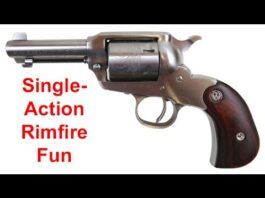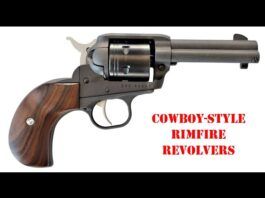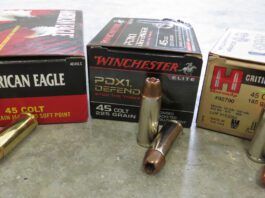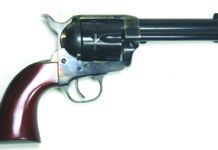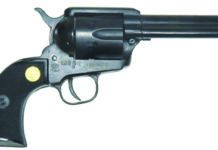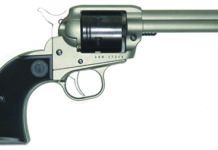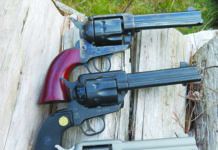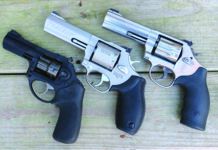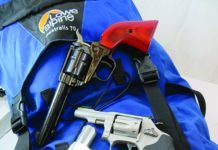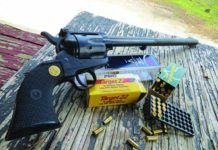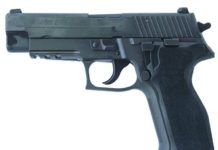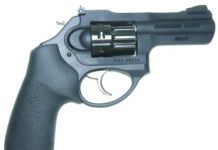Taurus Is Getting Busy with New Guns in 9mm, 22, 460
First Look Video: Smith & Wesson 351PD 22 Magnum Revolver
Uberti Cattleman 22 356186 22 LR
Cimarron Plinkerton ASPLINK1 22 LR
Ruger Wrangler 2003 22 LR
Cowboy Plinker Shoot Out: Cimarron, Ruger, and Uberti
22-Caliber Double Actions From Ruger, S&W, and Taurus
New Kit-Gun Revolvers from Charter Arms, S&W, Heritage
A Kit Gun, by definition, is a small-frame revolver that is packed up with rest of the kit when fishing, hiking, camping, hunting, or some other outdoor pursuit are being planned. The intention of the Kit Gun is to deal with pesky varmints raiding your cooler or a coiled viper in the middle of a foot trail that refuses to move. They also help decide bragging rights around the campfire after a session of plinking empty soda cans. These revolvers have been called Kit Guns since after WWI, but S&W was the first to use the name in 1935 on the 22/32 Kit Gun, which was built on the now-discontinued I-frame. This original Kit Gun had an adjustable rear sight, a DA/SA trigger, short barrel, and a smallish grip. Since then, the features of a Kit Gun have come to include single-action triggers, fixed sights, and snubnose-length barrels. It could be argued the semi-automatic 22 rimfire pistols have usurped the revolver's position, but that is for another test.
We took a look at three of the latest packable handguns, which included a S&W Model 317-3 Kit Gun, Charter Arms Pathfinder Lite, and Heritage Manufacturing's Small Bore single action. We were looking for a lightweight revolver that was accurate enough to shoot the head of a snake at 10 yards, had the ability to accurately fire a variety of 22 rimfire ammo, and be safe should we accidentally drop the revolver while trekking through the great outdoors.
We tested at 10 yards, which we thought was an optimum distance for these rimfires and used a variety of 22 rimfire ammo, including 22 LR with a range of bullet weights and types, 22 Short, and 22 Shot cartridges. Ammo consisted of commonly found CCI Mini Mag with a 36-grain copper-plated hollowpoint (CPHP), CCI Target 22 Short with a 29-grain lead roundnose (LRN) bullet, Browning BPR 37-grain fragmenting hollowpoints, and the hot Aguila Supermaximum loaded with a 30-grain CPHP. We also tested Federal Game-Shok Shot cartridges loaded with #12 shot. We used a rest and fired the revolvers in single-action mode to gauge accuracy. Then we let loose, plinking away in both DA and SA mode, using a two-hand hold until all the ammo was gone. Here's what we found out.
A Trio of Unusual Revolvers: Worth the Trouble and Money?
Most gun owners want firearms they can shoot and have fun with, even their life-and-death carry guns. Some of us also want the unusual because we like a walk on the wild side, irrespective of whether it has any use beyond messing around with or plinking. In this Special Report, we take a look at three wheelguns for which there are little or no match ups to find, so head-to-head testing isn't possible. But even without something to shoot beside them, we can learn plenty about whether some unique, or nearly unique, handguns are worth the time and trouble to find and add to your collection as a real, firing item.
Herewith then, we look at the Nagant M1895 7.62x38mmR, the Smith & Wesson Model 929 9mm Luger, and the Chiappa Buntline 22 LR.
2016 Guns & Gear Top Picks
Toward the end of each year, I survey the work R.K. Campbell, Roger Eckstine, Austin Miller, Robert Sadowski, David Tannahill, Tracey Taylor, John Taylor, Rafael Urista, and Ralph Winingham have done in Gun Tests, with an eye toward selecting guns, accessories, and ammunition the magazine's testers have endorsed. From these evaluations I pick the best from a full year's worth of tests and distill recommendations for readers, who often use them as shopping guides. These choices are a mixture of our original tests and other information I've compiled during the year. After we roll high-rated test products into long-term testing, I keep tabs on how those guns do, and if the firearms and accessories continue performing well, then I have confidence including them in this wrap-up.


























